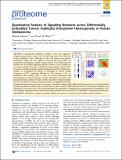| dc.contributor.author | Johnson, Hannah | |
| dc.contributor.author | White, Forest M. | |
| dc.date.accessioned | 2015-06-22T13:09:54Z | |
| dc.date.available | 2015-06-22T13:09:54Z | |
| dc.date.issued | 2014-06 | |
| dc.date.submitted | 2014-04 | |
| dc.identifier.issn | 1535-3893 | |
| dc.identifier.issn | 1535-3907 | |
| dc.identifier.uri | http://hdl.handle.net/1721.1/97485 | |
| dc.description.abstract | Glioblastoma multiforme (GBM) is the most aggressive malignant primary brain tumor, with a dismal mean survival even with the current standard of care. Although in vitro cell systems can provide mechanistic insight into the regulatory networks governing GBM cell proliferation and migration, clinical samples provide a more physiologically relevant view of oncogenic signaling networks. However, clinical samples are not widely available and may be embedded for histopathologic analysis. With the goal of accurately identifying activated signaling networks in GBM tumor samples, we investigated the impact of embedding in optimal cutting temperature (OCT) compound followed by flash freezing in LN[subscript 2] vs immediate flash freezing (iFF) in LN[subscript 2] on protein expression and phosphorylation-mediated signaling networks. Quantitative proteomic and phosphoproteomic analysis of 8 pairs of tumor specimens revealed minimal impact of the different sample processing strategies and highlighted the large interpatient heterogeneity present in these tumors. Correlation analyses of the differentially processed tumor sections identified activated signaling networks present in selected tumors and revealed the differential expression of transcription, translation, and degradation associated proteins. This study demonstrates the capability of quantitative mass spectrometry for identification of in vivo oncogenic signaling networks from human tumor specimens that were either OCT-embedded or immediately flash-frozen. | en_US |
| dc.description.sponsorship | James S. McDonnell Foundation | en_US |
| dc.description.sponsorship | United States-Israel Binational Science Foundation | en_US |
| dc.description.sponsorship | National Institutes of Health (U.S.) (Grant U54 CA112967) | en_US |
| dc.description.sponsorship | National Institutes of Health (U.S.) (Grant U24 CA159988) | en_US |
| dc.language.iso | en_US | |
| dc.publisher | American Chemical Society (ACS) | en_US |
| dc.relation.isversionof | http://dx.doi.org/10.1021/pr500418w | en_US |
| dc.rights | Article is made available in accordance with the publisher's policy and may be subject to US copyright law. Please refer to the publisher's site for terms of use. | en_US |
| dc.source | American Chemical Society | en_US |
| dc.title | Quantitative Analysis of Signaling Networks across Differentially Embedded Tumors Highlights Interpatient Heterogeneity in Human Glioblastoma | en_US |
| dc.type | Article | en_US |
| dc.identifier.citation | Johnson, Hannah, and Forest M. White. “Quantitative Analysis of Signaling Networks Across Differentially Embedded Tumors Highlights Interpatient Heterogeneity in Human Glioblastoma.” Journal of Proteome Research 13, no. 11 (November 7, 2014): 4581–4593. © 2014 American Chemical Society | en_US |
| dc.contributor.department | Massachusetts Institute of Technology. Department of Biological Engineering | en_US |
| dc.contributor.department | Koch Institute for Integrative Cancer Research at MIT | en_US |
| dc.contributor.mitauthor | Johnson, Hannah | en_US |
| dc.contributor.mitauthor | White, Forest M. | en_US |
| dc.relation.journal | Journal of Proteome Research | en_US |
| dc.eprint.version | Final published version | en_US |
| dc.type.uri | http://purl.org/eprint/type/JournalArticle | en_US |
| eprint.status | http://purl.org/eprint/status/PeerReviewed | en_US |
| dspace.orderedauthors | Johnson, Hannah; White, Forest M. | en_US |
| dc.identifier.orcid | https://orcid.org/0000-0002-1545-1651 | |
| mit.license | PUBLISHER_POLICY | en_US |
| mit.metadata.status | Complete | |
